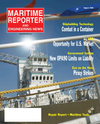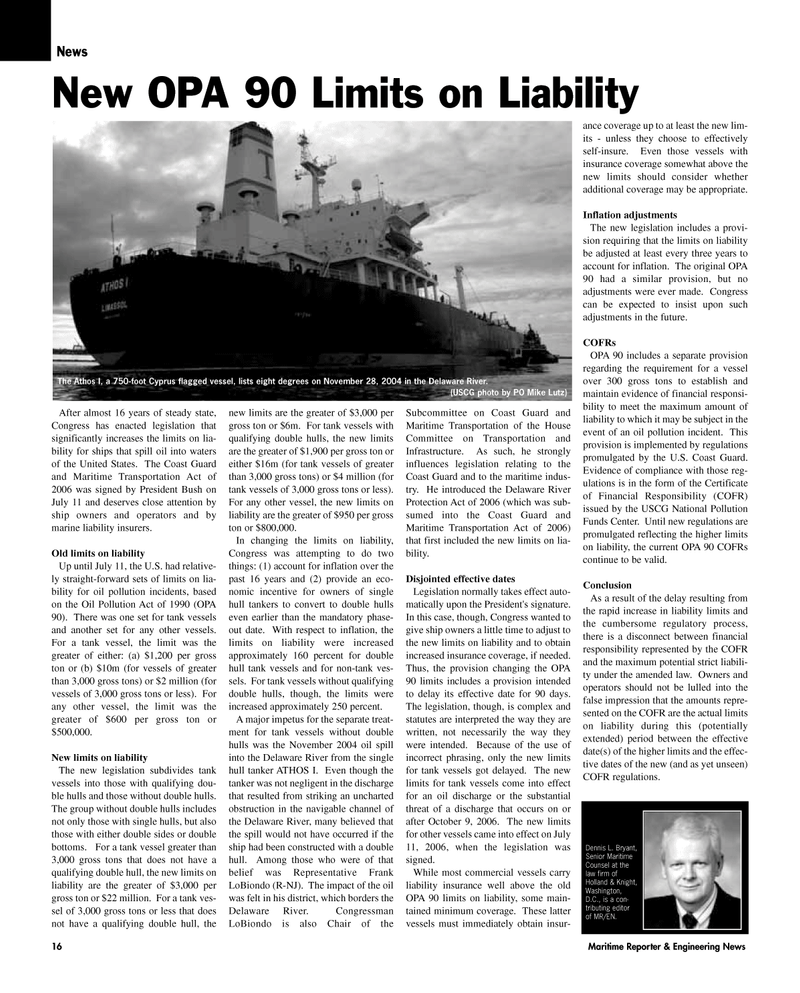
Page 16: of Maritime Reporter Magazine (August 2006)
AWO Edition: Inland & Offshore Waterways
Read this page in Pdf, Flash or Html5 edition of August 2006 Maritime Reporter Magazine
After almost 16 years of steady state,
Congress has enacted legislation that significantly increases the limits on lia- bility for ships that spill oil into waters of the United States. The Coast Guard and Maritime Transportation Act of 2006 was signed by President Bush on
July 11 and deserves close attention by ship owners and operators and by marine liability insurers.
Old limits on liability
Up until July 11, the U.S. had relative- ly straight-forward sets of limits on lia- bility for oil pollution incidents, based on the Oil Pollution Act of 1990 (OPA 90). There was one set for tank vessels and another set for any other vessels.
For a tank vessel, the limit was the greater of either: (a) $1,200 per gross ton or (b) $10m (for vessels of greater than 3,000 gross tons) or $2 million (for vessels of 3,000 gross tons or less). For any other vessel, the limit was the greater of $600 per gross ton or $500,000.
New limits on liability
The new legislation subdivides tank vessels into those with qualifying dou- ble hulls and those without double hulls.
The group without double hulls includes not only those with single hulls, but also those with either double sides or double bottoms. For a tank vessel greater than 3,000 gross tons that does not have a qualifying double hull, the new limits on liability are the greater of $3,000 per gross ton or $22 million. For a tank ves- sel of 3,000 gross tons or less that does not have a qualifying double hull, the new limits are the greater of $3,000 per gross ton or $6m. For tank vessels with qualifying double hulls, the new limits are the greater of $1,900 per gross ton or either $16m (for tank vessels of greater than 3,000 gross tons) or $4 million (for tank vessels of 3,000 gross tons or less).
For any other vessel, the new limits on liability are the greater of $950 per gross ton or $800,000.
In changing the limits on liability,
Congress was attempting to do two things: (1) account for inflation over the past 16 years and (2) provide an eco- nomic incentive for owners of single hull tankers to convert to double hulls even earlier than the mandatory phase- out date. With respect to inflation, the limits on liability were increased approximately 160 percent for double hull tank vessels and for non-tank ves- sels. For tank vessels without qualifying double hulls, though, the limits were increased approximately 250 percent.
A major impetus for the separate treat- ment for tank vessels without double hulls was the November 2004 oil spill into the Delaware River from the single hull tanker ATHOS I. Even though the tanker was not negligent in the discharge that resulted from striking an uncharted obstruction in the navigable channel of the Delaware River, many believed that the spill would not have occurred if the ship had been constructed with a double hull. Among those who were of that belief was Representative Frank
LoBiondo (R-NJ). The impact of the oil was felt in his district, which borders the
Delaware River. Congressman
LoBiondo is also Chair of the
Subcommittee on Coast Guard and
Maritime Transportation of the House
Committee on Transportation and
Infrastructure. As such, he strongly influences legislation relating to the
Coast Guard and to the maritime indus- try. He introduced the Delaware River
Protection Act of 2006 (which was sub- sumed into the Coast Guard and
Maritime Transportation Act of 2006) that first included the new limits on lia- bility.
Disjointed effective dates
Legislation normally takes effect auto- matically upon the President's signature.
In this case, though, Congress wanted to give ship owners a little time to adjust to the new limits on liability and to obtain increased insurance coverage, if needed.
Thus, the provision changing the OPA 90 limits includes a provision intended to delay its effective date for 90 days.
The legislation, though, is complex and statutes are interpreted the way they are written, not necessarily the way they were intended. Because of the use of incorrect phrasing, only the new limits for tank vessels got delayed. The new limits for tank vessels come into effect for an oil discharge or the substantial threat of a discharge that occurs on or after October 9, 2006. The new limits for other vessels came into effect on July 11, 2006, when the legislation was signed.
While most commercial vessels carry liability insurance well above the old
OPA 90 limits on liability, some main- tained minimum coverage. These latter vessels must immediately obtain insur- ance coverage up to at least the new lim- its - unless they choose to effectively self-insure. Even those vessels with insurance coverage somewhat above the new limits should consider whether additional coverage may be appropriate.
Inflation adjustments
The new legislation includes a provi- sion requiring that the limits on liability be adjusted at least every three years to account for inflation. The original OPA 90 had a similar provision, but no adjustments were ever made. Congress can be expected to insist upon such adjustments in the future.
COFRs
OPA 90 includes a separate provision regarding the requirement for a vessel over 300 gross tons to establish and maintain evidence of financial responsi- bility to meet the maximum amount of liability to which it may be subject in the event of an oil pollution incident. This provision is implemented by regulations promulgated by the U.S. Coast Guard.
Evidence of compliance with those reg- ulations is in the form of the Certificate of Financial Responsibility (COFR) issued by the USCG National Pollution
Funds Center. Until new regulations are promulgated reflecting the higher limits on liability, the current OPA 90 COFRs continue to be valid.
Conclusion
As a result of the delay resulting from the rapid increase in liability limits and the cumbersome regulatory process, there is a disconnect between financial responsibility represented by the COFR and the maximum potential strict liabili- ty under the amended law. Owners and operators should not be lulled into the false impression that the amounts repre- sented on the COFR are the actual limits on liability during this (potentially extended) period between the effective date(s) of the higher limits and the effec- tive dates of the new (and as yet unseen)
COFR regulations.
News
New OPA 90 Limits on Liability
Dennis L. Bryant,
Senior Maritime
Counsel at the law firm of
Holland & Knight,
Washington,
D.C., is a con- tributing editor of MR/EN. 16 Maritime Reporter & Engineering News
The Athos I, a 750-foot Cyprus flagged vessel, lists eight degrees on November 28, 2004 in the Delaware River. (USCG photo by PO Mike Lutz)
MR AUGUST2006 #2 (9-16).qxd 8/2/2006 5:17 PM Page 16

 15
15

 17
17
